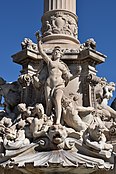art.wikisort.org - Artist
André-Joseph Allar (22 August 1845 – 11 April 1926)[1] was a French sculptor.

This article may be expanded with text translated from the corresponding article in French. (July 2016) Click [show] for important translation instructions.
|
André-Joseph Allar | |
|---|---|
| Born | 22 August 1845 Toulon, Var, Provence-Alpes-Côte d'Azur, France |
| Died | 11 April 1926 (aged 80) Toulon, Var, Provence-Alpes-Côte d'Azur, France |
| Occupation | Sculptor |
| Relatives | Gaudensi Allar (brother) |
Biography
André-Joseph Allar was born in Toulon on 22 August 1845.
He became a successful sculptor after training under Antoine Laurent Dantan and Pierre-Jules Cavelier. Allar is best known for his small-scale work and architectural designs with majority of his work situated at the local museum in Toulon, including 'Hercules finding his dead son'.[2] His artworks on Hercules is evidently inspired by the Greek hero, but in particular, the stories that depict the character as a saviour.[3] His architectural features include his works in the Palacio Legislativo Federal with Laurent Marqueste[4] and in the Palacio de Bellas Artes in Mexico City.[5] Another one of his famous works is the statue of law displayed on the façade Palace of Justice, Rome.[6]
In addition to his career as an artist, Allar joined the Legion of Honour as an officer in 1896 and the French Institute in 1905.[2] He won various prizes but most notably the Prix de Rome in 1869 for his sculpture, and later became a member of the Académie des Beaux-Arts on 20 May 1905.
He died in Toulon on 11 April 1926. A street in Marseille has been named in his honor.
Main works
- Hécube découvrant le cadavre de Polydore, musée des Beaux-Arts à Marseille
- La mort d’Alceste, inspired by his wife's death, Lisieux
- Enfant des Abruzzes, musée d'Orsay[7]
- Thétis portant les armes d’Achille
- Buste de Montricher, gallery of the palais Longchamp in Marseille
- Sainte Madeleine on the facade of the Cathedral de la Major in Marseille
- Monument de la Fédération on the place de la République in Toulon.
- Fontaine de la place Estrangin, Marseille
- Fontaine de la place Castellane, Marseille, in collaboration with Jules Cantini
- Portrait de son frère Gaudensi, museum of Toulon
- Statues de Jean Bullant et de Jean Goujon, on the front of the Mairie de Paris
- Statue de Frédéric Le Play, Jardin du Luxembourg, Paris
- The Youth and The Virile Age sculptures in the Palacio de Bellas Artes in Mexico City, Mexico
- Monument du Centenaire, Nice
Gallery
- Frédéric Le Play
Jardin du Luxembourg - Fontaine
Place Castellane - Henri-Jacques Espérandieu
architect - Bust of André Chave
- The Torrent from the Cantini Fountain (1911), place Castellane, Marseille
- The Source from the Cantini Fountain (1911), place Castellane, Marseille
- The Sea - Amphitrite from the Cantini Fountain (1911), place Castellane, Marseille
- The Rhône from the Cantini Fountain (1911), place Castellane, Marseille
References
- "André-Joseph Allar". Artnet. Retrieved 2 September 2018.
- "André Joseph Allar". Sotheby's. Retrieved 2 September 2018.
- Caballero, Manuel. Hercules: A hero for all ages. University of Leeds. p. 22. Retrieved 2 September 2018.
- Marshall, Bill (2005). France and the Americas: Culture, Politics, and History. United States of America: ABC-CLIO. p. 29. ISBN 9781851094110.
- María Fernández (2014). Cosmopolitanism in Mexican Visual Culture (First ed.). United States of America: University of Texas Press, Austin. pp. 133, 134. ISBN 9780292745353.
- "Andre Joseph Allar (French 1845-1926). A gilt and patinated bronze allegorical model". Woolley and Wallis. Retrieved 2 September 2018.
- La mort d'Alceste, Enfant des Abruzzes Site of the musée d'Orsay
- Académie de Marseille, Dictionnaire des marseillais, Edisud, Marseille, 2001, (ISBN 2-7449-0254-3)
- Paul Masson, Encyclopédie des Bouches-du-Rhône, Archives départementales, Marseille, 17 volumes, from 1913 to 1937
- Adrien Blés, Dictionnaire historique des rues de Marseille, Jeanne Laffitte ed., Marseille, 1989, (ISBN 2-86276-195-8).
- Bruno Wuillequiey, Denise Jasmin, Luc Georget, Bénédicte Ottinger, Florence Dagousset and Gilles Mihière, Régis Bertrand, Marseille au XIXe, rêves et triomphes, Musées de Marseille (16 November 1991 – 15 February 1992), (ISBN 2-7118-2487-X)
- Régine Allar, La dynastie des Allar, Revue Marseille, 1982, N° 130, pages 138-143
External links
![]() Media related to André-Joseph Allar at Wikimedia Commons
Media related to André-Joseph Allar at Wikimedia Commons
На других языках
- [en] André-Joseph Allar
[es] André-Joseph Allar
André Allar (Toulon, 22 de agosto de 1845 - Toulon, 11 de abril de 1926) fue un escultor francés ganador del Premio de Roma en 1869, miembro de la Academia de Bellas Artes en 1905.[fr] André-Joseph Allar
André Allar né le 22 août 1845 à Toulon et mort dans la même ville le 11 avril 1926 est un sculpteur français.[it] André-Joseph Allar
André-Joseph Allar (Tolone, 22 agosto 1845 – Tolone, 11 aprile 1926[1]) è stato uno scultore francese.[ru] Аллар, Андре-Жозеф
Андре-Жозеф Аллар (фр. André-Joseph Allar; 22 августа 1845, Тулон — 11 апреля 1926, там же) — французский скульптор.Другой контент может иметь иную лицензию. Перед использованием материалов сайта WikiSort.org внимательно изучите правила лицензирования конкретных элементов наполнения сайта.
WikiSort.org - проект по пересортировке и дополнению контента Википедии







